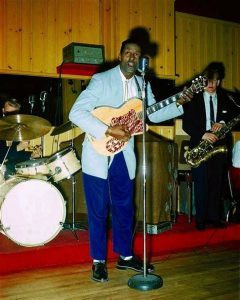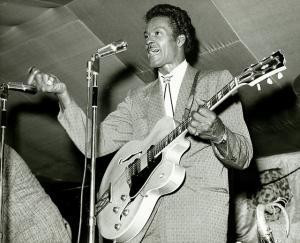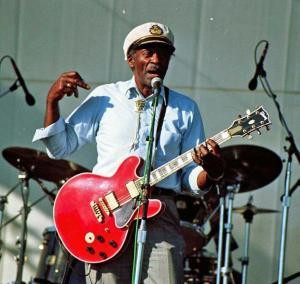Chuck Berry, a name synonymous with rock and roll, revolutionized music with his electrifying guitar riffs and dynamic stage presence. Since his groundbreaking hit “Maybellene” in 1955, guitarists worldwide have strived to capture the essence of his iconic sound, deeply intertwined with the guitars he wielded. From Angus Young of AC/DC to Keith Richards of The Rolling Stones, Berry’s influence on rock guitar is undeniable. His innovative style and choice of instruments have cemented his place as the true architect of rock and roll guitar.
 Chuck Berry playing his Kay Thin Twin guitar
Chuck Berry playing his Kay Thin Twin guitar
Early Guitars: Kay Thin Twin and Gibson ES-350 Models
While famously associated with Gibson guitars later in his career, Chuck Berry’s early journey saw him playing a Kay Thin Twin K-161. This guitar marked his initial steps in shaping the rock and roll sound. However, it was the Gibson ES series that truly became central to his signature tone.
During his formative years and prolific period with Chess Records, Berry primarily relied on the 1957 Gibson ES-350T. This model, equipped with Gibson’s pioneering P.A.F. humbucker pickups, was instrumental in crafting the majority of his classic recordings. Its versatile sound and comfortable thin body made it a stage and studio favorite. Adding to his collection of ES-350s, Berry also frequently played a 1956 Gibson ES-350TN, a hollow-body version with a distinctive thin natural finish. This guitar was often seen during his numerous television appearances, further embedding its image into the burgeoning rock and roll consciousness.
Eric Clapton, a devoted admirer of Berry, was so captivated by the ES-350TN that he acquired the same model as a tribute. Clapton recounted a memorable experience playing alongside Berry in 1986, hoping to impress his idol with the guitar. However, in a humorous anecdote, Clapton admitted that Berry remained completely oblivious to the instrument choice, highlighting Berry’s focus was always purely on the music itself.
 Chuck Berry playing his 1956 Gibson ES-350TN Photo by Irving Williamson
Chuck Berry playing his 1956 Gibson ES-350TN Photo by Irving Williamson
The Enduring Gibson ES-335 Era
By the late 1950s, Chuck Berry’s affinity for the Gibson ES series was well-established. The introduction of the Gibson ES-335 in 1958, coinciding with the release of his hit “Sweet Little Sixteen,” marked another significant chapter in his guitar journey. The ES-335, a semi-hollow body guitar, became a constant companion for Berry until his passing. He championed this model for its balanced tone, sustain, and feedback resistance at higher volumes, perfectly suiting his evolving stage performances and recording needs.
Although photographed with several ES-335s throughout his career, it is speculated that some were provided for convenience during travel, ensuring his performances were never without this essential tool. Beyond the 335, Berry was also seen with a Gibson ES-330, a fully hollow-body cousin, and even a sophisticated black Gibson Les Paul Custom, showcasing his occasional ventures into different Gibson models.
The Iconic Gibson ES-355 and Beyond
The most visually and sonically iconic guitar inextricably linked to Chuck Berry is undoubtedly his cherry red Gibson ES-355. While he owned and played various iterations of this top-of-the-line ES model, some featuring Maestro vibratos, others Bigsby tremolos, and some with no vibrato systems at all, the ES-355 is readily identifiable by its elegant split diamond inlay on the headstock. This guitar became a visual trademark, as recognizable as his duckwalk and infectious smile.
 Chuck Berry with the Gibson Lucille Signature guitar Photo by Masahiro Sumori
Chuck Berry with the Gibson Lucille Signature guitar Photo by Masahiro Sumori
Beyond his favored Gibsons, Berry explored other guitar brands, notably Gretsch. Images exist of him playing a 1959 Gretsch 6121 Roundup, a Gretsch 6120, and the visually striking Gretsch G6136DC White Falcon double cutaway. These forays into Gretsch guitars demonstrate his broader appreciation for quality instruments and diverse sonic palettes.
In his later years, Chuck Berry’s guitar choices continued to evolve, with photographs capturing him playing a vibrant cherry red 1967 Gibson Flying V and a luxurious Gibson Super 400. While the whereabouts of some of these guitars remain unknown, some are preserved in museums, offering glimpses into his rich musical history. In a poignant final tribute, Chuck Berry was buried with his cherished Gibson ES-355 in 2017, ensuring his music and his guitar legacy remain eternally intertwined.
